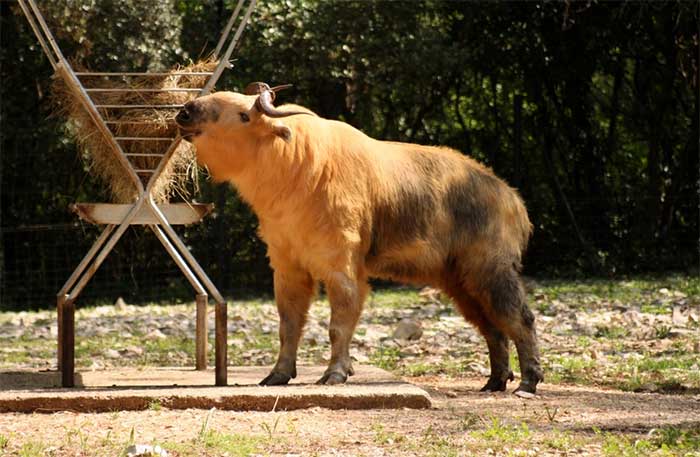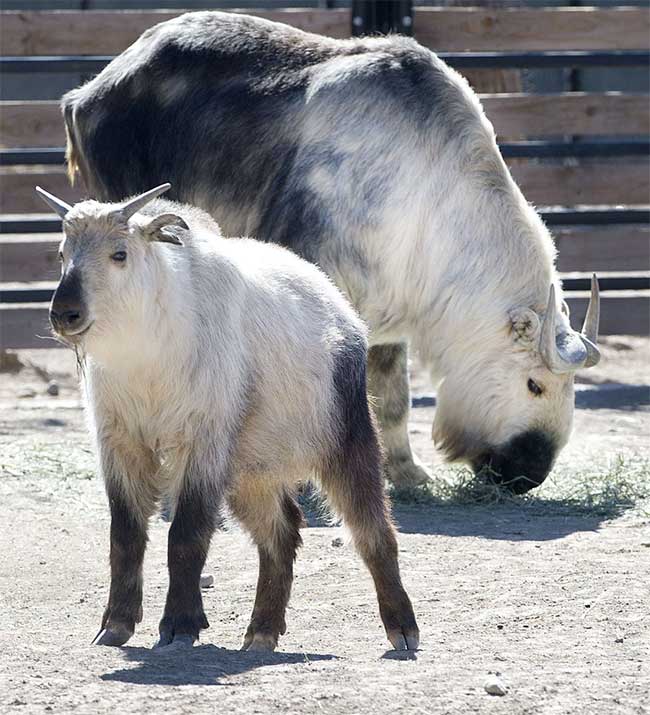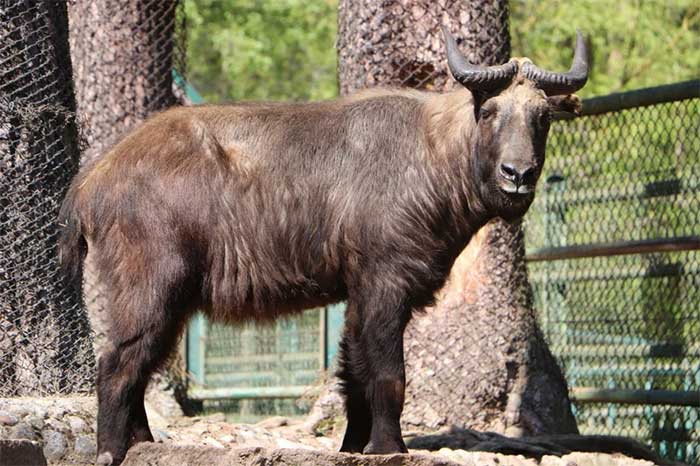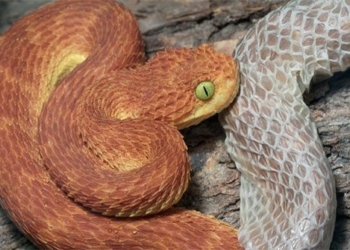The shape of the Lin Niu is quite strange, exhibiting characteristics of various animals, such as a bear’s body, a cow’s back, a horse’s face, a sheep’s tail, antelope-like horns, and features of a hyena in its hind legs.
There are four subspecies of Lin Niu worldwide: Qinling Lin Niu, Sichuan Lin Niu, Bhutan Lin Niu, and Gongshan Lin Niu. All four of these Lin Niu subspecies are found in China.
Lin Niu is a large and robust animal, with adult weights reaching up to 400 kg, and some individuals can weigh around 1 ton. Both male and female Lin Niu have horns on their heads, which twist inward and then outward, giving rise to its name “Lin Niu.”
There are certain differences in their coat colors among the various subspecies, and generally, the further north they live, the lighter their fur becomes. For instance, the Qinling Lin Niu has fur that is mostly light yellow or pale yellow, with slightly yellowish-white tones that change over time; as they age, their fur becomes more golden.

In fact, there are four animals considered treasures of the Qinling Mountains: the giant panda, golden monkey, Lin Niu, and the Nipponia nippon stork. Among them, Lin Niu is a giant herbivore, and due to its bizarre appearance, which combines features of many different animals, it is referred to as a “sacred beast” or “six-unlike-beasts.”
Although the Lin Niu generally resembles a cow and appears harmless to humans and other animals, its muscular build and sharp horns indicate that things are not as simple as they seem.
Lin Niu in the wild have a very aggressive temperament and prefer to use violence to solve problems. Even other herbivores are not allowed to enter their feeding areas, and if outsiders invade their territory, these animals will immediately resort to violence to drive them away.
Lin Niu is also one of the wild animals that injures humans the most in China, earning it the nickname “Killer King of Qinling” among internet users.
According to a 2008 report by the Chengdu Business Daily, the population of Lin Niu has surged over the past ten years, leading to more than 150 incidents of human injury, resulting in over 20 fatalities.

Lin Niu has 4 subspecies.
Investigations into Lin Niu attacks on humans reveal that most of the attacking Lin Niu are solitary males, while groups of Lin Niu are less likely to attack humans.
Lin Niu are highly social and often live in large groups, ranging from dozens to hundreds of individuals. However, some mature male Lin Niu prefer to live alone, making their temperaments much more aggressive than their counterparts.
During mating season, male Lin Niu will fight to the death for a mate, and the horns on their heads are their most important weapons in battle. To make their horns sharper and smoother, they often use tree trunks to polish them.

Due to their enormous size and after the disappearance of the South China tiger from the wild, Lin Niu have become species without natural enemies. They prefer to live in herds, often moving together in groups of over a dozen, and they move in an orderly manner. Mature males will position themselves at the front and back of the herd to protect females and young, which makes it difficult for predators like leopards and wild dogs to harm them.
In their daily lives, apart from eating and resting, a very important activity is polishing their horns with tree trunks. For example, in the Lin Niu habitat of the Qinling Mountains, we often see several bare tree trunks, a result of Lin Niu rubbing their horns against them, leading to accumulated friction that wears away the bark. In the Guangdou Mountain area of the Qinling Mountains, many felled trees can be seen, which is a phenomenon after the trunks have been damaged by Lin Niu rubbing against them and being affected by pests.
Consequently, in zoos, barbed wire is used to surround tree trunks to prevent this behavior of Lin Niu, as a damaged large tree poses a significant danger to safety. Sometimes, to better protect the tree trunk and consider the habits of the Lin Niu herd, when installing barbed wire, some tree trunks are also nailed to the outer ring for the Lin Niu to rub against.

Lin Niu in zoos have lost their wildness, but many of their living habits are still preserved, such as their preference for polishing their horns with tree trunks.
In fact, there are many animals in the wild that exhibit similar behaviors; for example, wild boars, which are commonly known, also enjoy rubbing their skin against tree trunks.
Additionally, there are animals like beavers, known as “nature’s architects,” who enjoy collecting tree trunks to dam rivers and build dams. They have strong incisors that can gnaw through large trees from below; for instance, along the Ulungu River in Xinjiang, you can see several gnawed trunks, which are masterpieces of the Mengxin beaver. In the United States, barbed wire fences are also used to protect tree trunks from being gnawed by beavers.

Although Lin Niu are herbivorous, they possess aggressive temperaments comparable to those of tigers and leopards. Males often engage in one-on-one fights, where they establish their rank within the herd through violence, and the losing individuals leave the herd and live a solitary life.




















































